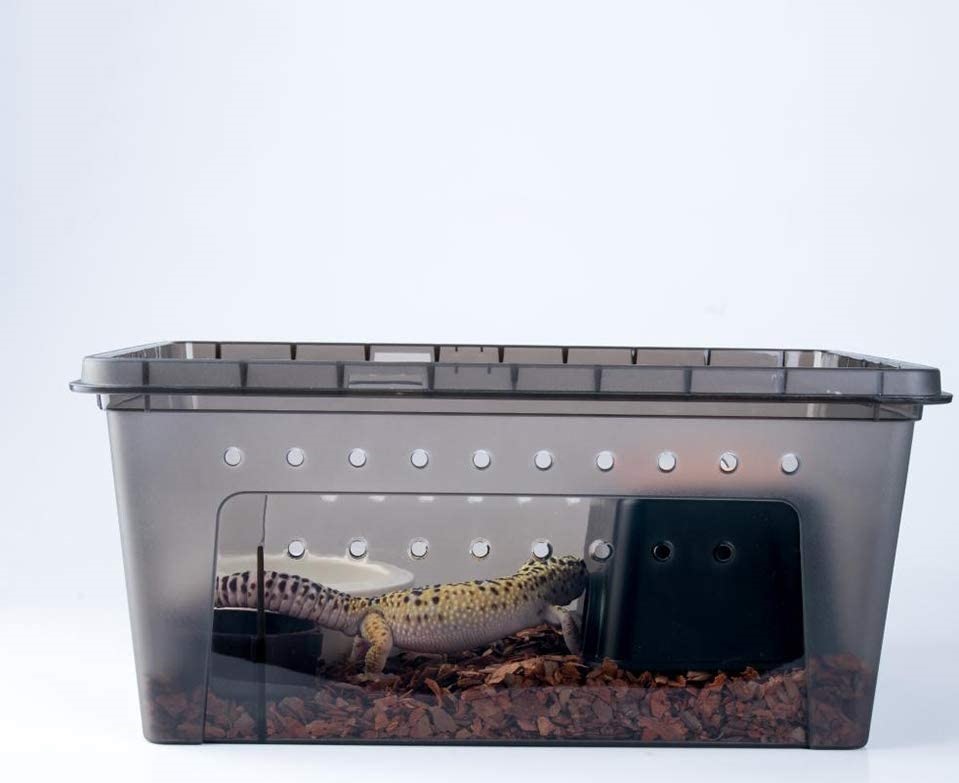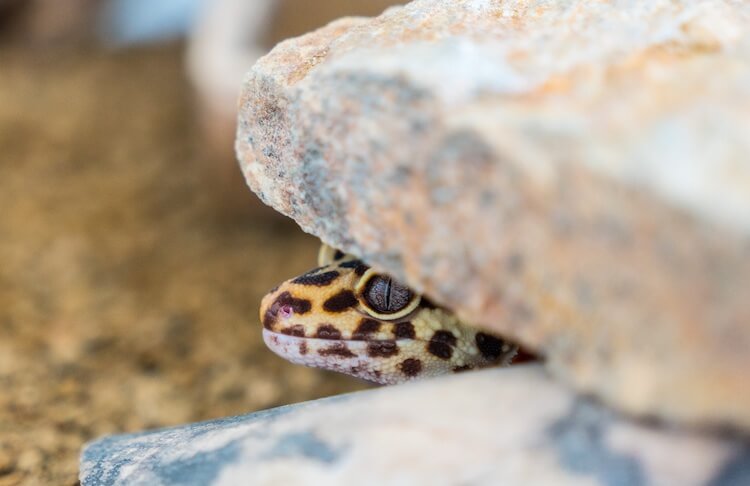Hygiene in the tank is incredibly important if you want to keep your leopard gecko healthy. Not everything that is harmless for humans is harmless for reptiles and amphibians. This cleaning guide will give you all the onformation you need to know on how to keep your gecko’s tank clean.
Why you need to clean your gecko’s terrarium
Unlike in the wild, animals in terrariums can’t move out of the way if something displeases them. They have no way to avoid germs and bacteria which accumulate over time and thus protect themselves. For this reason, you must ensure that your gecko’s habitat remains clean.
Sooner or later mites or other creey crawlies will appear in your gecko’s terrarium. They will first colonize the furnishings and then attack the inhabitants. Once the parasites are there, their removal can be long and tedious. In this case the best treatment is prevention. And the best way to prevent this from happening is to keep the tank clean.
Besides your pet’s heath, good hygiene also helps to prevent the terrarium from becoming a source of unpleasant odors, keeping your home stink-free.
First things firts
Never clean the tank if your gecko is still in it – this will stress it out. Always place your gecko in a travel container and provide it with a hiding space to minimize stress and make it feel comortable.

How often do you need to clean a leopard gecko tank
Leopard geckos are relatively low-maintenance pets, but they do require some daily, weekly, monthly and yearly cage upkeep. Every day, give their tank a spot cleaning and take out any excrement you may discover. Depending on the kind of substrate you’re using, you may also need to change or clean it weekly.
If you’re using paper towels as your substrate, they’ll need to be changed 1-2 times per week. And once every month, you’ll need to thoroughly clean the leopard gecko’s tank. This entails taking off all attachments and scrubbing the inside of the tank as well as all of them.
Daily cleaning
One of the daily care tasks is the removal of feces and urine. The easiest way to remove fresh excrement is by using kitchen towels. Dry excrement can be removed with a substrate scoop or – if it has dried on a stone, for example – with water and a cloth. In addition, food and drinking bowls should be rinsed with hot water daily before filling. Last but not least is the removal of leftover food or… their remains. This also applies to any skin remains of your gecko. The best way to do this is with tweezers.
Weekly cleaning
My weekly cleaning task consist of taking out and washing all feeding accessories. It is surprising how much dirt can acumulate in your gecko’s feeding bow. This is also a good time to throw away any lefover calcium powder.
How do you sterilize reptile accessories?
Most accessories can be cleaned with a sponge, dish soap and hot water. To sterilize, you can let the food and water bowl soak in boiling water to kill all bacteria.
Avoid washing the components of your leopard gecko’s cage in the primary kitchen sink. It is preferable to wash all of the accessories in a tub with a special sponge after placing them all in a designated bucket. Wear gloves and thoroughly wash your hands after handling the items. Sand should not be used as a substrate in the tank because it can harbor bacteria and parasites.
Keeping the air in the tank clean
Proper ventilation is also important: while drafts can cause colds, stagnant, stale air can lead to serious illness. Therefore, make sure to strike a healthy balance between sufficient air supply and avoiding drafts. It may be a good idea to air out the tank once a week. This of course depends on how often you interract with your gecko and take it out of its home.
Monthly cleaning
One of the monthly tasks is cleaning any glass panes and sliding doors. Depending on how dirty your panels get you may use a steam cleaner. Lime residues,for example, can be loosened and removed with the help of a steam cleaner.
Personal experience: I have never had to use a steam cleaner because my panels never get that dirty. I use a regular windor cleaner on the outside of the pannels and hot soapy water on the inside. I make sure to dry both sides befe letting my gecko back in its enclocure.
Yearly cleaning
Now we come to a cleaning interval that often causes discussion among many exotic pet keepers. Some people recommend to completely empty the entire terrarium once a year and to carefully clean and disinfect all individual components. This also includes completely renewing the substrate anfeeding accessories.
However, there are also pet owners who believe this to not be necessary as long as you keep up the daily, weekly and monthly cleaning.
Personal experience: At the end of the day it is up to you. I personally recommend doing one big clean up every year. I do it as part of my apartment spring clean. I only replace the substrate, but not the feeding bows unless they have been damaged.
What should I clean my leopard gecko tank with?
Using hot water and dish soap for cleaning can be sufficient, but there are some reptile safe cleaning supplies you can look for. They are food-safe and contain neither a corrosive effect nor toxic chemicals.
Can I use vinegar to clean gecko’s tank?
Yes. Vinegar is an excellent substitute for bleach since it won’t hurt your gecko once he or she is put back inside the cage and will help remove any bacteria that is alive and developing within the cage of your gecko. Just make sure to dilute it with water A 50:50 mix should be safe.
Other useful tips on keeping your gecko’s tank clean
Don’t forget to wash your hands
Don’t forget to wash your own hands when handling you gecko or doing any maintanence in its habitat. Germs and bacteria lurk on our hands, which are harmless for us, but can cause damage in the terrarium. So before you do even the smallest work in the terrarium, you should clean your hands with soap.
Same goes for when you are done. Always wash your hand after handling your leopard gecko or any parts of its terrarium.
Avoid cross-tank contamination
If you are keeping several animals in different tanks, it’s best to use separate tools for each terrarium. What I mean by this is that each terrarium should have its own tweezers, feeding tongs and scissors. This way you prevent the spread of germs or parasites across multiple terrariums.
Don’t feed your gecko’s lefovers to other reptiles
Last but not least, never feed uneaten food to ther reptiles you may keep. If you pick crickets from tank to another this may spread harmful germs to other terrariums. If your leopard gecko has not eaten its food, simpy remove it from the tank and put it back where you took it from (if still alive and edible).
